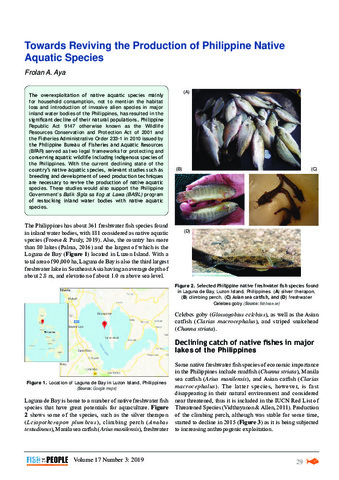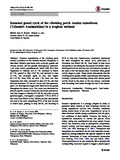Perlihatkan publikasi sederhana
Reproduction, early development, and larval rearing of the climbing perch Anabas testudineus (Teleostei: Anabantidae) in captivity
| dc.contributor.author | Aya, Frolan | |
| dc.contributor.author | Gutierrez, Reylan C. | |
| dc.contributor.author | Garcia, Luis Maria | |
| dc.date.accessioned | 2023-06-14T06:44:51Z | |
| dc.date.available | 2023-06-14T06:44:51Z | |
| dc.date.issued | 2023-06 | |
| dc.identifier.citation | Aya, F. A., Gutierrez, R. C., & Garcia, L. M. B. (2023). Reproduction, early development, and larval rearing of the climbing perch Anabas testudineus (Teleostei: Anabantidae) in captivity. Philippine Agricultural Scientist, 106(2), 197-207. | en |
| dc.identifier.issn | 0031-7454 | |
| dc.identifier.uri | http://hdl.handle.net/10862/6449 | |
| dc.description.abstract | Induced spawning, early development, and larval rearing of the climbing perch Anabas testudineus were examined under captive conditions. Five female climbing perch [125.33 ± 3.27 mm standard length (SL); 70.67 ± 5.59 g body weight (BW)] were each paired with apparently mature males (108.50 ± 3.97 mm SL; 39.27 ± 4.70 g BW) and induced to spawn with 5,000 IU human chorionic gonadotropin (hCG) + 0.5 mL Ovaprim/kg BW. All hCG + Ovaprim-injected fish spawned 9 – 11 h after hormone administration but saline-injected fish (control group) failed to spawn. Mean egg production per female, fertilization and hatching rates, and larval production per female were 7,667 ± 1,313, 98.11 ± 1.63%, 61.01 ± 19.92%, and 4,435 ± 1,041, respectively. Fertilized eggs (1.52 – 1.96 mm in diameter) were almost spherical, non-adhesive, transparent, and buoyant due to a large, single oil globule (515 ± 33 µm in diameter). First cleavage appeared 30 min post-fertilization (MPF) and egg development lasted for 20 – 24 h post-fertilization (HPF) (29°C). Newly hatched climbing perch larvae [1.73 ± 0.08 mm in total length (TL)] with yolk volume (YV) and oil globule volume (OGV) of 0.545 ± 0.104 mm3 and 0.072 ± 0.013 mm3, respectively had no pigmented eyes or functional mouth parts and digestive tract, and immobile with the yolk sac pointed upward. Eyes became pigmented and both mouth and anus opened in 1 d old larvae (2.09 ± 0.04 mm TL) in preparation for exogenous feeding. Except for body depth (BD) and pre-anal length (PAL), a general increase in TL (1.73 – 3.72 mm), eye diameter (ED) (0.164 – 0.378 mm), head length (HL) (0.205 – 0.923 mm), and mouth gape (MG) size (0.308 – 0.552 mm) was observed, coinciding with yolk resorption in 7 d post-hatched larvae. Climbing perch larvae were reared at four stocking densities (25, 50, 75, 100 larvae L-1) and fed solely on live food (Brachionus rotundiformis from days 2 to 12 and Artemia nauplii from days 13 to 40) or co-fed live food and microparticulate diet (MPD) (Artemia nauplii from days 2 to 15 and Artemia + MPD from days 16 to 40). Mean survival rates at lower densities (25 – 50 larvae L-1) were significantly higher than those reared at 75 and 100 larvae L-1 (P < 0.05). Furthermore, climbing perch larvae co-fed Artemia nauplii and MPD showed better survival (28.67 – 81.00%) than those fed solely on live food (24.88 – 64.00%). However, at the end of the 40 d trial period, growth parameters did not vary significantly among densities (P > 0.05), except for the condition factor in larvae co-fed Artemia nauplii and MPD. Taken together, results demonstrate the effectiveness of hCG + Ovaprim for captive breeding and observations on the early development of climbing perch, and the feasibility of rearing the larvae at 25 – 50 L-1 on a combination of Artemia nauplii and MPD under laboratory conditions. | en |
| dc.description.sponsorship | This study was supported by the SEAFDEC/AQD (Nr-02-F2013B and Br-02-F2015B). | en |
| dc.language.iso | en | en |
| dc.publisher | College of Agriculture and Food Science, University of the Philippines Los Baños | en |
| dc.subject | Anabas testudineus | en |
| dc.subject | precocity | en |
| dc.subject | perch | en |
| dc.title | Reproduction, early development, and larval rearing of the climbing perch Anabas testudineus (Teleostei: Anabantidae) in captivity | en |
| dc.type | Article | en |
| dc.citation.volume | 106 | en |
| dc.citation.issue | 2 | en |
| dc.citation.spage | 197 | en |
| dc.citation.epage | 207 | en |
| dc.citation.journalTitle | Philippine Agricultural Scientist | en |
| dc.subject.asfa | reproduction | en |
| dc.subject.asfa | induced ovulation | en |
| dc.subject.asfa | growth | en |
| dc.subject.asfa | survival | en |
| dc.subject.asfa | stocking density | en |
| dc.subject.asfa | larvae | en |
| dc.subject.asfa | captivity | en |
| dc.subject.scientificName | Anabas testudineus | en |
| local.subject | Anabas testudineus | en |
| local.subject | feeding regime | en |
| local.subject | growth | en |
| local.subject | stocking density | en |
| local.subject | survival | en |
Files in this item
| Files | Size | Format | View |
|---|---|---|---|
|
There are no files associated with this item. |
|||
Publikasi ini ada di koleksi berikut
-
Journal Articles [1258]
These papers were contributed by Department staff to various national and international journals.




